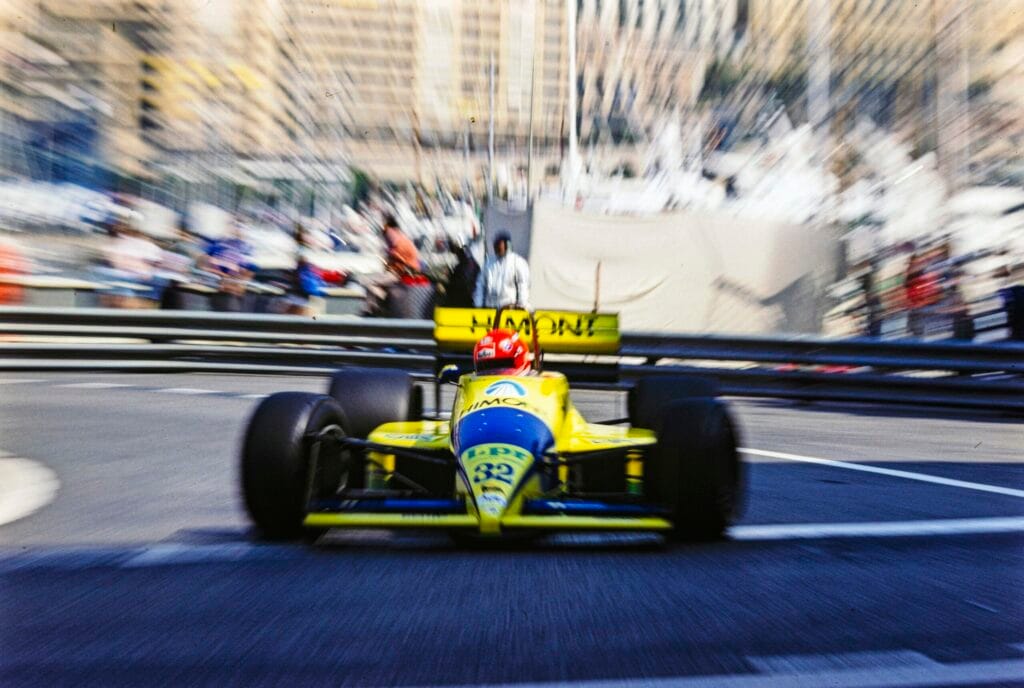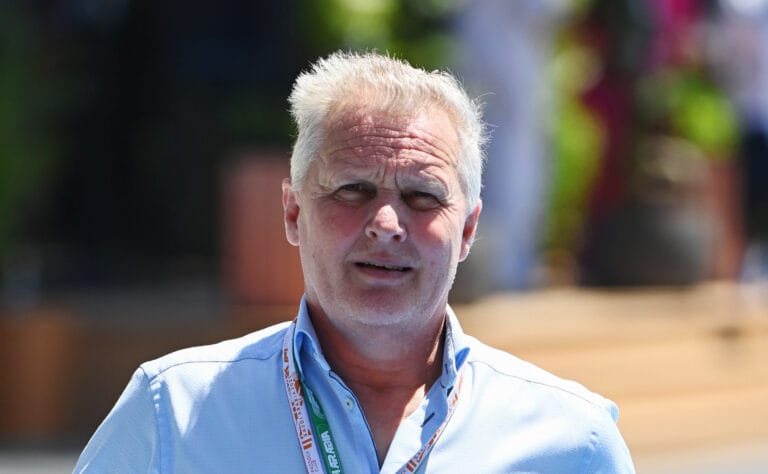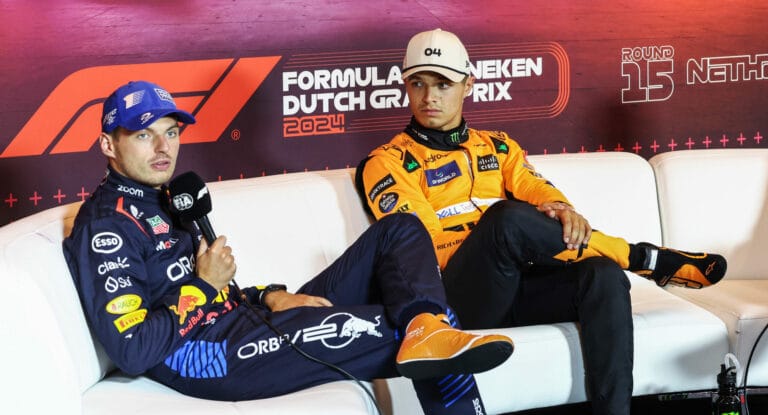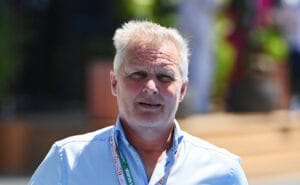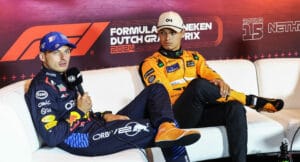Is it truly necessary to have a thousand staff members and an annual budget of 135 million to operate two Formula 1 cars? Things were quite different 35 years ago. Drivers Gabriele Tarquini and Pierre Henri Raphanel share their experiences from their time at Coloni, the F1 team that could fit into a single minivan. “Of course, a tire change took a while with only four mechanics.”
Between 1987 and 1991, Coloni was active in Formula 1. However, if you wanted to catch a glimpse of the team during those years, you had to be an early bird. A Coloni car only started a Grand Prix sixteen times, and only four times did one reach the finish line. Usually, a Grand Prix weekend was over by Friday morning when the pre-qualification ended the dreams of the smaller teams. For Gabriele Tarquini, now 62 years old, this was no reason to back out of an agreement with his compatriot Enzo Coloni in 1988.
“I was very excited to start my first full season as a Formula 1 driver,” Tarquini recalls over the phone. “Coloni was a small team with its fair share of problems, and I knew that qualifying for the races would be a significant challenge. That year, there was a pre-qualification in which five drivers participated, and only the fastest four could proceed. Then, another four drivers were eliminated in the qualification. My goal was to qualify for the race, and I managed to do so eight times, half of all races. Not bad at all.”
Coloni’s biggest problem was the weight of the car, Tarquini explains. “It was sixty kilos heavier than the minimum weight. We managed to shed some kilos over the season, but by the end of the year, we were still forty kilos over. It’s hard to imagine that today. It cost us at least a second per lap. The balance was otherwise okay; it wasn’t a bad car in slow corners.”
An Alternative Approach
Initially, things don’t look too bad for Coloni. “At that time, there were many small teams and with some cleverness and a bit of luck, you could go a long way,” Tarquini refers to the technical regulations that banned turbo engines at the end of 1988. Smaller teams like Coloni pinned their hopes on Cosworth, which offered them an affordable alternative. “Without those expensive turbo engines, Formula 1 would become much cheaper, and that was reason enough for people like Enzo Coloni to take the leap to Formula 1.”
However, this did not take into account manufacturers like Honda and Renault who immediately invested so much in their own atmospheric engines that the Cosworths quickly fell hopelessly behind, creating a divide: the factory teams like Ferrari, McLaren, and Williams with their V10 and V12 engines, followed by a brigade of small teams all with the same Cosworth V8. To come out on top in this group, you had to be of good stock, explains Tarquini. “Like many teams, Coloni did a lot themselves: the chassis and gearbox were developed and built in-house. They might have been better off outsourcing some of that work, but there was no money for that. You also noticed that many parts were simply worn out by the end of the season. Engine mounts and control arms suddenly broke off.”
Good Hope
In 1989, Enzo Coloni still had confidence. Designers Michel Costa and Christian Vanderpleyn drew a new car, the drivers that year were Roberto Moreno and Pierre Henri Raphanel. The latter brought sponsorship money from the French TV channel La Cinq. “They had joined under the promise of a new car, but it was constantly delayed,” Raphanel recalls. Nowadays, he is a test driver at Bugatti – Raphanel, among other things, fine-tuned the thousand horsepower Bugatti Veyron – but he gladly takes the time to recall his short Formula 1 career.
“Meanwhile, I had to make do with that old car. Did Tarquini tell you he was forty kilos overweight? That doesn’t surprise me, because I’m a big guy and I fit in easily. They had simply made that car too big.” In Brazil and Imola, Raphanel stumbled in the pre-qualification and sponsor La Cinq stopped payments to the team. “Another driver had already made a seat to take my place in Monaco, but Enzo Coloni knew that I had won the Formula 3 race in Monaco in 1985 so he wanted to give me another chance.”
Unbelievable Pre-Qualification Performance
In the pre-qualification, the unthinkable happens: Raphanel clocks the third fastest time. “It was my best lap ever. I don’t think I could ever repeat it. Anyway, for the first time, I was allowed to participate in the training and qualification.” However, things don’t go smoothly: Raphanel crashes and doesn’t record a time. “It was supposed to rain on Saturday, and then I would have been done for. But it stayed dry and I was ready to give it my all, until… Philippe Alliot didn’t move aside and I lost my front wing. With the only other front wing we had left, I drove an all-or-nothing lap and qualified eighteenth for the race!”
‘Well, Now It’s a Good Story…’
This is the first, and ultimately the only time that two Colonis start a Grand Prix. It’s also the only GP start of Raphanel’s Formula 1 career. “After nineteen laps, the gearbox broke. Enzo Coloni was neither surprised nor disappointed, and afterwards I heard that it was an old gearbox that would never have lasted. If I had known that, I would have asked the mechanics to only half-fill the tank, so I could have moved up further. Well, now it’s a good story, but at the time I was gutted…”
The new car is still not ready. All the manpower the team has is being used up. “We had to go to Mexico knowing that the old car would be hopeless there. So Coloni sent just one car, four mechanics, Roberto Moreno and me to that race. During the pre-qualification, Moreno held my pit board and a tire change naturally took forever with only one mechanic per wheel, but it was already hopeless.”
New Car, Same Old Story
In Canada, the Coloni C3 is finally ready. At least, one of them is. “So we went to a Grand Prix with just one car again,” Raphanel recounts. “Since Moreno was exempt from the pre-qualification, I had to do a sort of shakedown in that one hour on Friday morning, so he could take over the car afterwards.” This strategy works: while Raphanel only does a few outlaps in the pre-qualification and constantly has to have a plug, hose or nut tightened, Moreno can qualify without any problems a few hours later. He drops out of the race in sight of the finish. Raphanel: “That didn’t give me reason for optimism. I knew the money was running out, and more and more people were leaving because they couldn’t be paid on time. It’s a shame, because the car was quite good.”
A Change of Scenery
Raphanel leaves before the end of the year for Rial, a German team with even worse prospects, but at least he is exempt from pre-qualification. “The Rial was worse than the Coloni and the chance of me qualifying for the race was small, but at least I could participate in the training and qualification. This way, I could keep my sponsor happy for a while longer.”
Raphanel’s place at Coloni is taken by Enrico Bertaggia. In the six remaining Grand Prix weekends, Bertaggia does not get further than the last place in pre-qualification, with the Coloni falling apart in Belgium and Japan during the first lap. Raphanel: “Parts were repaired provisionally. In Suzuka, Enrico’s wheel suspension broke off in the first corner. I didn’t want to deal with that anymore.”
Not a Dreamer
Miraculously, Coloni lasts until the end of 1991. By then, the team consists of only six people. However, Gabriele Tarquini explains that Enzo Coloni is always looking for ways to keep his team afloat until the end. “What I thought was a very smart move by Enzo Coloni was to enlist the help of the University of Perugia. They had a faculty of aerospace and the students there got a real Formula 1 team as a study object. Of course, it was all a bit of guesswork, because we didn’t have the money to really test the things they designed there. If they designed a new front wing in Perugia, we just took it to the next Grand Prix and hoped it would do what it was supposed to do.”
‘Enzo Coloni is a Real Racer, Not a Dreamer or Fantasist’
Of course, this was a hopeless strategy, but even now, years later, Tarquini has a lot of respect for his former team boss. “Enzo Coloni is a real racer, not a dreamer or fantasist like some other owners of small teams from that time. He knows exactly what he needs to be successful in motorsport. Unfortunately, in Formula 1 he never had the means to move his team forward. He also tried to hold out for a long time without resorting to pay drivers. Coloni recognized the importance of a good driver and thought for a long time that he would make it with that strategy. I believe there were about twenty people working for Coloni in the year I drove for them, but in 1991, their last season, there were only six. Then you know it’s over.”
Despite this, Tarquini retains good memories. “My best result was the eighth place in Canada. Now I would have scored points with that! And in Imola, I qualified seventeenth. I’m still proud of that.”


